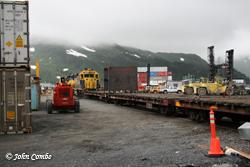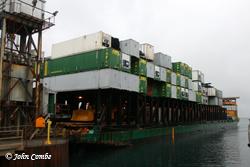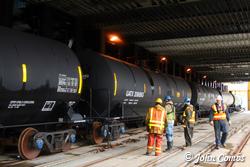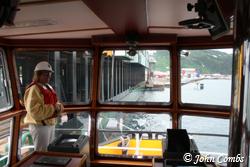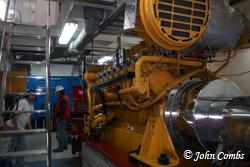Wednesday, July 16, 2008
Terry and I had breakfast with retired ARR locomotive engineer
Frank Dewey at the Mixed Grill restaurant in "The Towers" next
door to Don's condo. Frank loves to give
his prized possessions away to friends. Thus, I became the recipient of two
large framed and matted Alaska Railroad steam locomotive builder's photos.
It
was an awesome gift indeed and I vowed to ship them home professionally. On
a previous trip, he gave me a large framed Alaska Railroad train painting.
I
chose to box it up and check it as baggage on my flight home. By the time it
hit the baggage carousel in Dayton, the box was badly damaged and torn open.
The painting was fine, but I realized just how extremely lucky I had been.
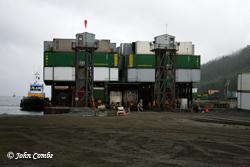 Today's
special activity were to observe barge unloading at Whittier. Ted Woodward was
handling the operations there and we met him at the security gate. Terry and
I donned our high visibility jacket, safety glasses, hard hat and steel toed
boots. Ted then supplied us with life jackets and a brief safety talk. As we
walked out toward the dock, Ted explained that three companies had freight on
board the barge today - Alaska Railroad, Lynden and Northland Services. He said
although the barge can hold over 50 railcars, only 41 were on board today. The
second level was fully loaded and held over 100 trailer containers which would
be fork lifted off and loaded onto railroad flat cars. Ted directed Terry and
I to a 100' x 30' safe zone nearby where we could grab some photos and video
while staying out of harm's way.
Today's
special activity were to observe barge unloading at Whittier. Ted Woodward was
handling the operations there and we met him at the security gate. Terry and
I donned our high visibility jacket, safety glasses, hard hat and steel toed
boots. Ted then supplied us with life jackets and a brief safety talk. As we
walked out toward the dock, Ted explained that three companies had freight on
board the barge today - Alaska Railroad, Lynden and Northland Services. He said
although the barge can hold over 50 railcars, only 41 were on board today. The
second level was fully loaded and held over 100 trailer containers which would
be fork lifted off and loaded onto railroad flat cars. Ted directed Terry and
I to a 100' x 30' safe zone nearby where we could grab some photos and video
while staying out of harm's way.
To prepare for barge unloading, steel cables are connected
from hoists stationed on the dock to the barge. Next, the hoists are used to
pull the cables left or right until the rails on the barge are aligned with
those on the dock. Once this occurs, a temporary connection is put in place.
Now railcar freight can be unloaded. Today GP38 numbers 2002 and 2008 would
serve as switchers. In front of them were two flat cars known as idler flats.
What is an idler flat? I'm glad you asked. The joint between the barge and the
dock is very weak. In order to avoid losing freight or locomotives, old flat
cars are used to serve as a connector between the two. Flat cars work best for
the task since they are lightweight and do not block visibility. Now let the
unloading begin!
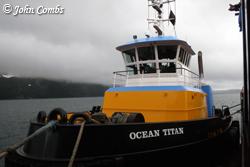 I
am always intrigued by the variety of items that emerge from the barge. Yes,
there were your typical tank, hopper and box cars. However, we also saw large
construction equipment, fishing boats, army vehicles and some stuff that defies
description (see photo above of steel poles with yellow caps). The entire process
of unloading all the railcars on the Anchorage Provider barge took a total of
two hours and ten minutes. [click here
for 21.2MB video] Now that it was empty, Ted let Terry and I walk on board.
Call me silly, but I was pretty excited to be actually standing on the barge's
deck. Terry didn't seem to think it was a big deal so I guess only hardcore
foamers (such as myself!) could appreciate an experience such as this. Ted gave
us a brief barge tour and taught us how a barge actually works during the unloading
process. To help keep itself level after several rows of freight cars have been
removed, onboard ballast tanks compensate by draining their water. The barge
has six ballast tanks for leveling and it takes approximately 40 minutes to
pump each one dry.
I
am always intrigued by the variety of items that emerge from the barge. Yes,
there were your typical tank, hopper and box cars. However, we also saw large
construction equipment, fishing boats, army vehicles and some stuff that defies
description (see photo above of steel poles with yellow caps). The entire process
of unloading all the railcars on the Anchorage Provider barge took a total of
two hours and ten minutes. [click here
for 21.2MB video] Now that it was empty, Ted let Terry and I walk on board.
Call me silly, but I was pretty excited to be actually standing on the barge's
deck. Terry didn't seem to think it was a big deal so I guess only hardcore
foamers (such as myself!) could appreciate an experience such as this. Ted gave
us a brief barge tour and taught us how a barge actually works during the unloading
process. To help keep itself level after several rows of freight cars have been
removed, onboard ballast tanks compensate by draining their water. The barge
has six ballast tanks for leveling and it takes approximately 40 minutes to
pump each one dry.
Several employees came over to chat and I was surprised how
many of them were fans of my website. Ted then introduced me to Brett Spencer
who works for the Western Towboat Company.
He is the captain of the tugboat Ocean Titan that brought this barge from Seattle
to Whittier. Brett offered to give us a tour of his vessel and Terry and I both
politely declined. [Gasps of horror from those reading this journal] Just kidding!
Of course, we agreed to a tour! What do you think I am? Stupid? Don't answer
that.
 As
we boarded the Ocean Titan Brett explained tugboat operations. There are five
men on the crew, a captain, two mates and three workers. Before leaving the
Alaska Railbelt Marine terminal in Seattle, Washington, three guys board the
barge and spend 1-2 hours checking on the tie downs. Once the boat leaves the
terminal, Brett will pilot the tugboat for an eight hour shift while the two
mates will take the other shifts. Total trip time is typically on a three week
cycle taking one week to get from Seattle to Whittier and one week to get back.
They run the tug 24 hours a day and make approximate 11 mph on calm water. The
captain will tow the barge .4 miles behind the tugboat while in the ocean and
.17 miles behind while in the Inside Passage. He also must make sure the line
doesn't get too tight. Typically they stop every day to board the barge and
ensure the refrigerated units are running at the correct temperature.
As
we boarded the Ocean Titan Brett explained tugboat operations. There are five
men on the crew, a captain, two mates and three workers. Before leaving the
Alaska Railbelt Marine terminal in Seattle, Washington, three guys board the
barge and spend 1-2 hours checking on the tie downs. Once the boat leaves the
terminal, Brett will pilot the tugboat for an eight hour shift while the two
mates will take the other shifts. Total trip time is typically on a three week
cycle taking one week to get from Seattle to Whittier and one week to get back.
They run the tug 24 hours a day and make approximate 11 mph on calm water. The
captain will tow the barge .4 miles behind the tugboat while in the ocean and
.17 miles behind while in the Inside Passage. He also must make sure the line
doesn't get too tight. Typically they stop every day to board the barge and
ensure the refrigerated units are running at the correct temperature.
We entered the bridge and I was amazed at all the high tech
electronics gear it housed. The radar not only detected nearby ships, but
provided
their name and type. Equally impressive was the GPS van unit and command center.
However, what I really loved was the XM satellite radio feed and wireless
broadband
Internet. I noticed the laptop had a beautiful
ocean backdrop screen. When I asked, Captain Brett admitted taking the photo
himself. Turning to the laptop, Captain Brett brought up numerous photos
and video of the many journeys he had taken. What did I do? I begged him
to let me use some of these on my website.
There were also two pistol grip joysticks on the console. They
are used to control the twin Z drive Caterpillar #3516 engines. The Z drives
generate a total of 5,000 hp. They have no rudders, but can point the propellers
360 degrees. The windows are all heated and the vessel is equipped with central
heat and air conditioning.
Captain Brett then took us through the various levels of the
tugboat. Terry and I both were amazed at how big this little tug really was.
It boasted a full galley complete with oven, stove, broiler and dishwasher,
crew quarters, exercise equipment area, food storage and an enormous engine
room. Terry was awestruck by the cleanliness of the tugboat. As she said, "The
floors are clean enough to eat off of them." We saw not one rust bolt or
dirty corner. It is obvious this crew takes great pride in caring for their
craft. We thanked Captain Brett over and over again for a truly phenomenal tugboat
tour.
As we exited the tug, the longshoremen were jumping into action.
Using giant forklifts they went into a synchronized ballet of unloading the
container freight from the top deck of the barge. It is amazing to watch them
gracefully unload a container from the front port side, quickly pass by the
forklift unloading the front starboard side and then pass the container onto
a smaller forklift that will load it onto a railroad flatcar. The whole process
is free of mistakes and wasted motion.
 |
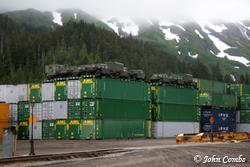 |
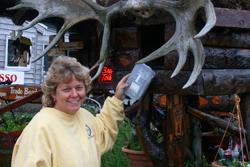 We
returned our life jackets to Ted and thanked him for being such a great escort.
Before leaving Whittier, however, we needed to do one more thing - retrieve
at least one geocache. I got out my GPS unit as Terry read the cache description
sheet. We drove to ground zero and Terry found the geocache (shown at left)
before I had even gotten out of the car. With our final checklist item accomplished,
we headed quickly to the tunnel to catch the next window of opportunity.
Feeling
a little bit inquisitive, I used my GPS to measure the elevation at both ends
of the tunnel. As it turned out, the Whittier end of tunnel is 75 feet above
sea level and the Bear Valley end is 164 feet above sea level. You might want
to hold onto this piece of information for the next time you are playing
Trivial Pursuit. You just never know when it might come in handy.
We
returned our life jackets to Ted and thanked him for being such a great escort.
Before leaving Whittier, however, we needed to do one more thing - retrieve
at least one geocache. I got out my GPS unit as Terry read the cache description
sheet. We drove to ground zero and Terry found the geocache (shown at left)
before I had even gotten out of the car. With our final checklist item accomplished,
we headed quickly to the tunnel to catch the next window of opportunity.
Feeling
a little bit inquisitive, I used my GPS to measure the elevation at both ends
of the tunnel. As it turned out, the Whittier end of tunnel is 75 feet above
sea level and the Bear Valley end is 164 feet above sea level. You might want
to hold onto this piece of information for the next time you are playing
Trivial Pursuit. You just never know when it might come in handy.
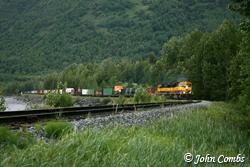 As
we drove back to Anchorage, we encountered a southbound freight train. Try as
I might, I could not find a very good place to snap the shot. Eager to get back
to the condo for dinner with Don, I just settled for the closest thing I could
get. It was not the best, but it would do.
As
we drove back to Anchorage, we encountered a southbound freight train. Try as
I might, I could not find a very good place to snap the shot. Eager to get back
to the condo for dinner with Don, I just settled for the closest thing I could
get. It was not the best, but it would do.
Derek had dinner ready as we walked in the door. When the dishes
were done, I gave Don a photo debriefing of the day's events while Terry made
cake and chocolate chip cookies. As we nibbled on dessert, I asked Don if he
would mind having Terry interview him for his life's history. He agreed and
Terry spent the rest of the evening asking questions and typing up his answers
on her laptop. There were some sad stories while others left us rolling on the
floor with laughter.
Day 11 | Index
| Day 13
 Today's
special activity were to observe barge unloading at Whittier. Ted Woodward was
handling the operations there and we met him at the security gate. Terry and
I donned our high visibility jacket, safety glasses, hard hat and steel toed
boots. Ted then supplied us with life jackets and a brief safety talk. As we
walked out toward the dock, Ted explained that three companies had freight on
board the barge today - Alaska Railroad, Lynden and Northland Services. He said
although the barge can hold over 50 railcars, only 41 were on board today. The
second level was fully loaded and held over 100 trailer containers which would
be fork lifted off and loaded onto railroad flat cars. Ted directed Terry and
I to a 100' x 30' safe zone nearby where we could grab some photos and video
while staying out of harm's way.
Today's
special activity were to observe barge unloading at Whittier. Ted Woodward was
handling the operations there and we met him at the security gate. Terry and
I donned our high visibility jacket, safety glasses, hard hat and steel toed
boots. Ted then supplied us with life jackets and a brief safety talk. As we
walked out toward the dock, Ted explained that three companies had freight on
board the barge today - Alaska Railroad, Lynden and Northland Services. He said
although the barge can hold over 50 railcars, only 41 were on board today. The
second level was fully loaded and held over 100 trailer containers which would
be fork lifted off and loaded onto railroad flat cars. Ted directed Terry and
I to a 100' x 30' safe zone nearby where we could grab some photos and video
while staying out of harm's way. 